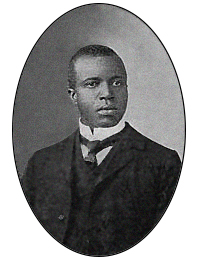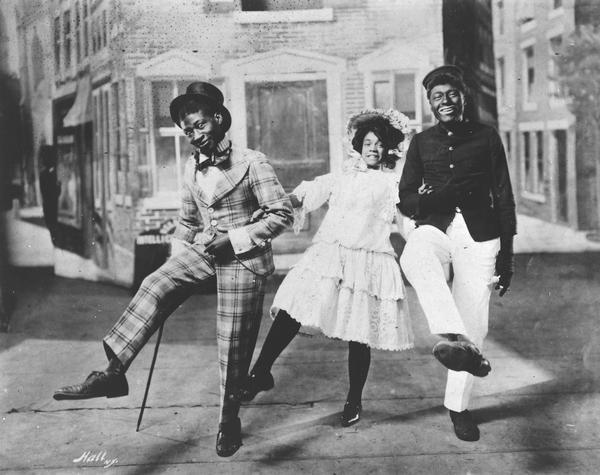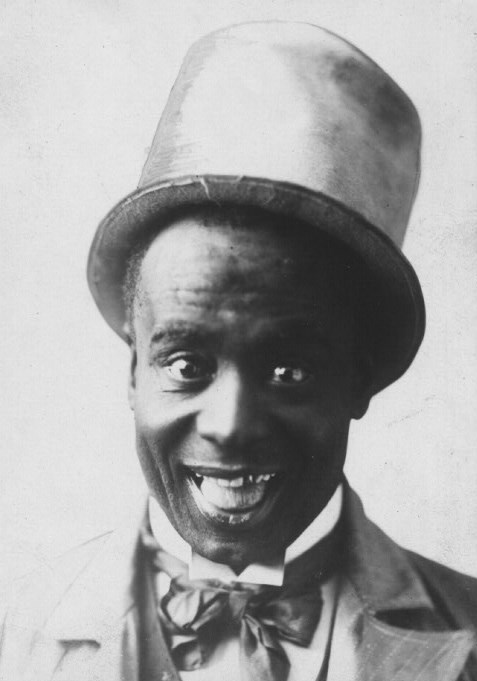|
Ragtime Piano
Ragtime, also spelled rag-time or rag time, is a musical style that flourished from the 1890s to 1910s. Its cardinal trait is its syncopated or "ragged" rhythm. Ragtime was popularized during the early 20th century by composers such as Scott Joplin, James Scott and Joseph Lamb. Ragtime pieces (often called "rags") are typically composed for and performed on piano, though the genre has been adapted for a variety of instruments and styles. " Maple Leaf Rag", " The Entertainer", "Fig Leaf Rag", "Frog Legs Rag", and "Sensation Rag" are among the most popular songs of the genre. The genre emerged from African American communities in the Southern and Midwestern United States, evolving from folk and minstrel styles and popular dances such as the cakewalk and combining with elements of classical and march music. Ragtime significantly influenced the development of jazz. In the 1960's, the genre had began to be revived with the publication '' The All Played Ragtime'' and artists re ... [...More Info...] [...Related Items...] OR: [Wikipedia] [Google] [Baidu] |
Cakewalk
The cakewalk was a dance developed from the "prize walks" (dance contests with a cake awarded as the prize) held in the mid-19th century, generally at get-togethers on Black Slavery in the United States, slave plantations before and after End of slavery in the United States of America, emancipation in the Southern United States. Alternative names for the original form of the dance were "chalkline-walk", and the "walk-around". It was originally a processional partner dance danced with comical formality, and may have developed as a subtle mockery of the mannered dances of white slaveholders. Following an exhibition of the cakewalk at the 1876 Centennial Exposition in Philadelphia, the cakewalk was adopted by performers in minstrel shows, where it was danced exclusively by men until the 1890s. At that point, Broadway shows featuring women began to include cakewalks, and grotesque dances became very popular across the country.. The fluid and graceful steps of the dance may have g ... [...More Info...] [...Related Items...] OR: [Wikipedia] [Google] [Baidu] |
Piano
The piano is a stringed keyboard instrument in which the strings are struck by wooden hammers that are coated with a softer material (modern hammers are covered with dense wool felt; some early pianos used leather). It is played using a keyboard, which is a row of keys (small levers) that the performer presses down or strikes with the fingers and thumbs of both hands to cause the hammers to strike the strings. It was invented in Italy by Bartolomeo Cristofori around the year 1700. Description The word "piano" is a shortened form of ''pianoforte'', the Italian term for the early 1700s versions of the instrument, which in turn derives from ''clavicembalo col piano e forte'' (key cimbalom with quiet and loud)Pollens (1995, 238) and ''fortepiano''. The Italian musical terms ''piano'' and ''forte'' indicate "soft" and "loud" respectively, in this context referring to the variations in volume (i.e., loudness) produced in response to a pianist's touch or pressure on the keys: the grea ... [...More Info...] [...Related Items...] OR: [Wikipedia] [Google] [Baidu] |
Ernest Hogan
Ernest Hogan (born Ernest Reuben Crowdus; 1865 – May 20, 1909) was the first African-American entertainer to produce and star in a Broadway show (''The Oyster Man'' in 1907) and helped to popularize the musical genre of ragtime. A native of Bowling Green, Kentucky, as a teenager Hogan worked in traveling minstrel shows as a dancer, musician, and comedian. In 1895 Hogan composed several popular songs, including "La Pas Ma La" and "All Coons Look Alike to Me". The success of the latter song created many derogatory imitations, known as "coon songs" because of their use of racist and stereotypical images of black people. Hogan was considered one of the most talented performers and comedians of his day.''Tap Roots: The Early History of Tap Dancing'' by Mark Knowles, McFarland & Company, 2002, , pages 119-20. His contribution to the racist "coon song" craze haunted him—before his death he stated that he regretted using the racial slur in his song. Early years He was born Ernest R ... [...More Info...] [...Related Items...] OR: [Wikipedia] [Google] [Baidu] |
La Pas Ma La
"La Pas Ma La" is the first ragtime composition to be published by minstrel performer Ernest Hogan in 1895. With his troupe, the Georgia Graduates Georgia most commonly refers to: * Georgia (country), a country in the Caucasus region of Eurasia * Georgia (U.S. state), a state in the Southeast United States Georgia may also refer to: Places Historical states and entities * Related to the ..., he performed a dance step and ditty with the name "Pasmala".Gushee, Lawrence"The Nineteenth-Century Origins of Jazz."Black Music Research Journal 14, no. 1 (1994): 1-24. doi:10.2307/779456. Hogan created a comedy dance called the "La Pas Ma La" , which consisted of a walk forward with three steps back. In 1895, he wrote and composed a song based on this dance called "pasmala".''Tap Roots: The Early History of Tap Dancing'' by Mark Knowles, McFarland & Company, 2002, , pages 119-20. The song's chorus was: :Hand upon yo' head, let your mind roll back, :Back, back back and look at the star ... [...More Info...] [...Related Items...] OR: [Wikipedia] [Google] [Baidu] |
Routledge
Routledge () is a British multinational publisher. It was founded in 1836 by George Routledge, and specialises in providing academic books, journals and online resources in the fields of the humanities, behavioural science, education, law, and social science. The company publishes approximately 1,800 journals and 5,000 new books each year and their backlist encompasses over 70,000 titles. Routledge is claimed to be the largest global academic publisher within humanities and social sciences. In 1998, Routledge became a subdivision and imprint of its former rival, Taylor & Francis Group (T&F), as a result of a £90-million acquisition deal from Cinven, a venture capital group which had purchased it two years previously for £25 million. Following the merger of Informa and T&F in 2004, Routledge became a publishing unit and major imprint within the Informa "academic publishing" division. Routledge is headquartered in the main T&F office in Milton Park, Abingdon, Oxfordshire and ... [...More Info...] [...Related Items...] OR: [Wikipedia] [Google] [Baidu] |
African-American
African Americans (also referred to as Black Americans and Afro-Americans) are an Race and ethnicity in the United States, ethnic group consisting of Americans with partial or total ancestry from sub-Saharan Africa. The term "African American" generally denotes descendants of Slavery in the United States, enslaved Africans who are from the United States. While some Black immigrants or their children may also come to identify as African-American, the majority of first generation immigrants do not, preferring to identify with their nation of origin. African Americans constitute the second largest racial group in the U.S. after White Americans, as well as the third largest ethnic group after Hispanic and Latino Americans. Most African Americans are descendants of enslaved people within the boundaries of the present United States. On average, African Americans are of West Africa, West/Central Africa, Central African with some European descent; some also have Native Americans in th ... [...More Info...] [...Related Items...] OR: [Wikipedia] [Google] [Baidu] |
Scott Joplin 19072
Scott may refer to: Places Canada * Scott, Quebec, municipality in the Nouvelle-Beauce regional municipality in Quebec * Scott, Saskatchewan, a town in the Rural Municipality of Tramping Lake No. 380 * Rural Municipality of Scott No. 98, Saskatchewan United States * Scott, Arkansas * Scott, Georgia * Scott, Indiana * Scott, Louisiana * Scott, Missouri * Scott, New York * Scott, Ohio * Scott, Wisconsin (other) (several places) * Fort Scott, Kansas * Great Scott Township, St. Louis County, Minnesota * Scott Air Force Base, Illinois * Scott City, Kansas * Scott City, Missouri * Scott County (other) (various states) * Scott Mountain, a mountain in Oregon * Scott River, in California * Scott Township (other) (several places) Elsewhere * 876 Scott, minor planet orbiting the Sun * Scott (crater), a lunar impact crater near the south pole of the Moon *Scott Conservation Park, a protected area in South Australia People * Scott (surname) Scott is a sur ... [...More Info...] [...Related Items...] OR: [Wikipedia] [Google] [Baidu] |
They All Played Ragtime
''They All Played Ragtime'' is a non-fiction book by journalist Rudi Blesh and author Harriet Janis, originally published by Grove Press in 1950. It was subsequently reissued in 1959, 1966, and 1971 by Oak Publications, and in 2007 by Nelson Press. According to the Preface to the Fourth Edition, by Rudi Blesh, the book was conceived and researched largely by Harriet Janis, who died in 1963. It is generally recognized as the pioneering and first serious book to document the history and major composers of ragtime in America, and has been referred to as ''The Bible of Ragtime''. Summary The book is divided into a prelude and thirteen chapters. It is the first book to document what is now regarded as the early ragtime triumvirate: Scott Joplin, James Scott, and Joseph Lamb. In a recorded discussion between Rudi Blesh and pianist Milton Kaye, Blesh revealed that for a long time the authors were not able to find out any information about Joseph Lamb, and that some believed the n ... [...More Info...] [...Related Items...] OR: [Wikipedia] [Google] [Baidu] |
Cakewalk
The cakewalk was a dance developed from the "prize walks" (dance contests with a cake awarded as the prize) held in the mid-19th century, generally at get-togethers on Black Slavery in the United States, slave plantations before and after End of slavery in the United States of America, emancipation in the Southern United States. Alternative names for the original form of the dance were "chalkline-walk", and the "walk-around". It was originally a processional partner dance danced with comical formality, and may have developed as a subtle mockery of the mannered dances of white slaveholders. Following an exhibition of the cakewalk at the 1876 Centennial Exposition in Philadelphia, the cakewalk was adopted by performers in minstrel shows, where it was danced exclusively by men until the 1890s. At that point, Broadway shows featuring women began to include cakewalks, and grotesque dances became very popular across the country.. The fluid and graceful steps of the dance may have g ... [...More Info...] [...Related Items...] OR: [Wikipedia] [Google] [Baidu] |
American Folk Music
The term American folk music encompasses numerous music genres, variously known as ''traditional music'', ''traditional folk music'', ''contemporary folk music'', ''vernacular music,'' or ''roots music''. Many traditional songs have been sung within the same family or folk group for generations, and sometimes trace back to such origins as the British Isles, Mainland Europe, or Africa. Musician Mike Seeger once famously commented that the definition of American folk music is "...all the music that fits between the cracks." American folk music is a broad category of music including bluegrass, gospel, old time music, jug bands, Appalachian folk, blues, Cajun and Native American music. The music is considered American either because it is native to the United States or because it developed there, out of foreign origins, to such a degree that it struck musicologists as something distinctly new. It is considered "roots music" because it served as the basis of music later develope ... [...More Info...] [...Related Items...] OR: [Wikipedia] [Google] [Baidu] |
African American
African Americans (also referred to as Black Americans and Afro-Americans) are an ethnic group consisting of Americans with partial or total ancestry from sub-Saharan Africa. The term "African American" generally denotes descendants of enslaved Africans who are from the United States. While some Black immigrants or their children may also come to identify as African-American, the majority of first generation immigrants do not, preferring to identify with their nation of origin. African Americans constitute the second largest racial group in the U.S. after White Americans, as well as the third largest ethnic group after Hispanic and Latino Americans. Most African Americans are descendants of enslaved people within the boundaries of the present United States. On average, African Americans are of West/ Central African with some European descent; some also have Native American and other ancestry. According to U.S. Census Bureau data, African immigrants generally do not s ... [...More Info...] [...Related Items...] OR: [Wikipedia] [Google] [Baidu] |
Sensation Rag
"Sensation Rag" or "Sensation" is a 1918 jazz instrumental by the Original Dixieland Jazz Band. It is one of the earliest jazz recordings. It is not related to Joseph Lamb's 1908 "Sensation Rag", which is a ragtime piano piece. Background The instrumental was recorded on June 25, 1918, in New York as a one-step and was released as a single on RCA Victor as Victor 18483 with "Bluin' the Blues" as the flip side. It was composed by Eddie Edwards, the trombonist in the Original Dixieland Jazz Band. Other recordings Bix Beiderbecke recorded the instrumental "Sensation" on September 16, 1924, and released as Gennett 78 single 5542 with "Lazy Daddy" as the flip side. "Sensation" was recorded by Fletcher Henderson and His Orchestra in 1927 and released on Vocalion, and by Joe Venuti's Big Four featuring Eddie Lang in 1928. "Sensation Rag" or "Sensation" was performed at the 1938 landmark Benny Goodman jazz concert at Carnegie Hall released on the album ''The Famous 1938 Carnegie Hall ... [...More Info...] [...Related Items...] OR: [Wikipedia] [Google] [Baidu] |









